Is it still possible to get Microsoft 70-462 dumps for free? Pass4itsure Microsoft 70-462 dumps exam (Administering Microsoft SQL Server 2012 Databases) offers free PDF demo to download. With the complete collection of questions and answers, pass4itsure has assembled to take you through 248 Q&As to your 70-462 exam preparation. This certificate proves that the candidate has an advanced understanding within database professionals who perform installation, maintenance, and configuration tasks. Microsoft https://www.pass4itsure.com/70-462.html dumps exam certifies a candidate’s knowledge on Microsoft Administering Microsoft SQL Server 2012 Databases components to perform onsite support and maintenance of it and related operating software. Other responsibilities include setting up database systems, making sure those systems operate efficiently, and regularly storing, backing up, and securing data from unauthorized access.
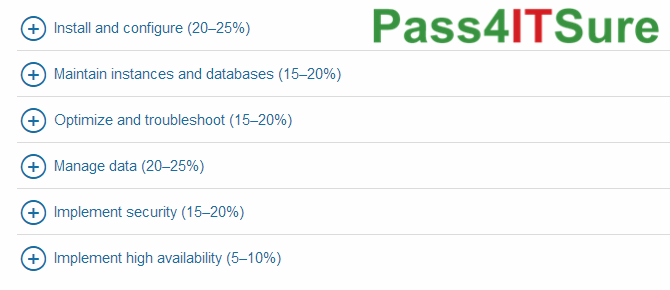
Free VCE & PDF File for Microsoft 70-462 Real Exam Quetsions(1-7)
Question No : 1 – (Topic 1)
You administer all the deployments of Microsoft SQL Server 2012 in your company.You need to ensure that an OLTP database that includes up-to-the-minute reporting requirements can be off-loaded from the primary database to another server. You also
need to be able to add indexes to the secondary database. Which configuration should you use?
A.
• Two servers configured in different data centers
• SQL Server Availability Group configured in Synchronous-Commit Availability Mode
• One server configured as an Active Secondary
B.
• Two servers configured in the same data center
• SQL Server Availability Group configured in Asynchronous-Commit Availability Mode
• One server configured as an Active Secondary
C.
• Two servers configured in the same data center
• A primary server configured to perform log-shipping every 10 minutes
• A backup server configured as a warm standby
D.
• Two servers configured in different data centers
• SQL Server Availability Group configured in Asynchronous-Commit Availability Mode
E.
• Two servers configured on the same subnet
• SQL Server Availability Group configured in Synchronous-Commit Availability Mode
F.
• SQL Server that includes an application database configured to perform transactional replication
G.
• SQL Server that includes an application database configured to perform snapshot replication
H.
• Two servers configured in a Windows Failover Cluster in the same data center
• SQL Server configured as a clustered instance
70-462 exam Answer: F
Question No : 2 – (Topic 1)
You administer all the deployments of Microsoft SQL Server 2012 in your company. You need to ensure that data changes are sent to a non-SQL Server database server in near real time. You also need to ensure that data on the primary server is unaffected. Which configuration should you use?
A. • SQL Server that includes an application database configured to perform transactional replication
B. • Two servers configured in different data centers
• SQL Server Availability Group configured in Asynchronous-Commit Availability Mode
C. • Two servers configured in different data centers
• SQL Server Availability Group configured in Synchronous-Commit Availability Mode
• One server configured as an Active Secondary
D. • SQL Server that includes an application database configured to perform snapshot replication
E. • Two servers configured in the same data center
• SQL Server Availability Group configured in Asynchronous-Commit Availability Mode
• One server configured as an Active Secondary
F. • Two servers configured on the same subnet
• SQL Server Availability Group configured in Synchronous-Commit Availability Mode
G. • Two servers configured in a Windows Failover Cluster in the same data center
• SQL Server configured as a clustered instance
H. • Two servers configured in the same data center
• A primary server configured to perform log-shipping every 10 minutes
• A backup server configured as a warm standby
Answer: A
Question No : 3 – (Topic 1)
You administer all the deployments of Microsoft SQL Server 2012 in your company. A database contains a large product catalog that is updated periodically. You need to be able to send the entire product catalog to all branch offices on a monthly
basis. Which configuration should you use?
A.
• Two servers configured in the same data center
• A primary server configured to perform log-shipping every 10 minutes
• A backup server configured as a warm standby
B.
• SQL Server that includes an application database configured to perform transactional replication
C.
• Two servers configured in the same data center
• SQL Server Availability Group configured in Asynchronous-Commit Availability Mode
• One server configured as an Active Secondary
D
• Two servers configured in a Windows Failover Cluster in the same data center
• SQL Server configured as a clustered instance
D.
• SQL Server that includes an application database configured to perform snapshot replication
E.
• Two servers configured in different data centers
• SQL Server Availability Group configured in Synchronous-Commit Availability Mode
• One server configured as an Active Secondary
F.
• Two servers configured on the same subnet
• SQL Server Availability Group configured in Synchronous-Commit Availability Mode
G.
• Two servers configured in different data centers
• SQL Server Availability Group configured in Asynchronous-Commit Availability Mode
70-462 dumps Answer: E
Question No : 4 – (Topic 1)
You administer all the deployments of Microsoft SQL Server 2012 in your company. You need to ensure that an OLTP database that uses a storage area network (SAN) remains available if any of the servers fail. You also need to minimize the amount of
storage used by the database. Which configuration should you use?
A.
• Two servers configured in different data centers
• SQL Server Availability Group configured in Synchronous-Commit Availability Mode
• One server configured as an Active Secondary
B.
• SQL Server that includes an application database configured to perform transactional replication
C.
• Two servers configured in the same data center
• SQL Server Availability Group configured in Asynchronous-Commit Availability Mode
• One server configured as an Active Secondary
D.
• Two servers configured in different data centers
• SQL Server Availability Group configured in Asynchronous-Commit Availability Mode
E.
• Two servers configured in the same data center
• A primary server configured to perform log-shipping every 10 minutes
• A backup server configured as a warm standby
F.
• Two servers configured on the same subnet
• SQL Server Availability Group configured in Synchronous-Commit Availability Mode
G.
• SQL Server that includes an application database configured to perform snapshot replication
H.
• Two servers configured in a Windows Failover Cluster in the same data center
• SQL Server configured as a clustered instance
Answer: H
Question No : 5 – (Topic 1)
You administer a Microsoft SQL Server 2012 server that hosts a transactional database and a reporting database. The transactional database is updated through a web application and is operational throughout the day. The reporting database is only updated from the transactional database. The recovery model and backup schedule are configured as shown in the following table:
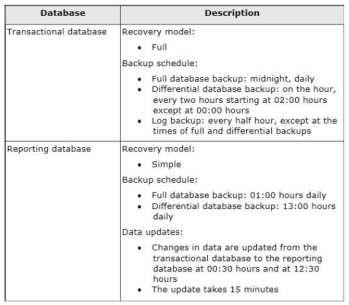
The differential backup of the reporting database fails. Then, the reporting database fails at 14:00 hours.
You need to ensure that the reporting database is restored. You also need to ensure that data loss is minimal.
What should you do?
A. Restore the latest full backup, and restore the latest differential backup. Then, restore the latest log backup.
B. Perform a point-in-time restore. C Restore the latest full backup.
C. Restore the latest full backup, and restore the latest differential backup. Then, restore each log backup taken before the time of failure from the most recent differential backup.
D. Restore the latest full backup. Then, restore the latest differential backup.
E. Restore the latest full backup. Then, restore each differential backup taken before the time of failure from the most recent full backup.
F. Perform a page restore.
G. Perform a partial restore.
70-462 pdf Answer: C
Question No : 6 – (Topic 1)
You administer a Microsoft SQL Server 2012 server that hosts a transactional database and a reporting database. The transactional database is updated through a web application and is operational throughout the day. The reporting database is only updated from the transactional database. The recovery model and backup schedule are configured as shown in the following table:
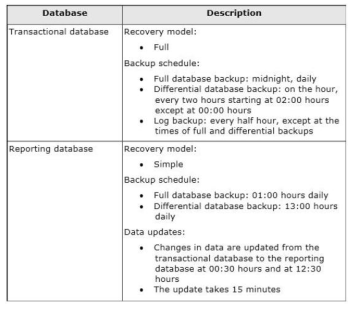
At 14:00 hours, you discover that pages 71, 520, and 713 on one of the database files are corrupted on the reporting database. You also need to ensure that data loss is minimal. What should you do?
A. Perform a partial restore.
B. Restore the latest full backup, and restore the latest differential backup. Then, restore
each log backup taken before the time of failure from the most recent differential backup.
C. Restore the latest full backup.
D. Restore the latest full backup, and restore the latest differential backup. Then, restore the latest log backup.
E. Perform a page restore.
F. Restore the latest full backup. Then, restore each differential backup taken before the time of failure from the most recent full backup.
G. Perform a point-in-time restore.
H. Restore the latest full backup. Then, restore the latest differential backup.
Answer: H
Explanation: Explanation/Reference:
Restores a file or filegroup in a multi-filegroup database. Note that under the simple recovery model, the file must belong to a read-only filegroup. After a full file restore, a differential file backup can be restored.
Page restore
Restores individual pages. Page restore is available only under the full and bulk-logged
recovery models
Piecemeal restore
Restores the database in stages, beginning with the primary filegroup and one or more secondary filegroups. A piecemeal restore begins with a RESTORE DATABASE using the PARTIAL option and specifying one or more secondary filegroups to be restored
Question No : 7 – (Topic 1)
You administer a Microsoft SQL Server 2012 server that hosts a transactional database and a reporting database. The transactional database is updated through a web application and is operational throughout the day. The reporting database is only updated from the transactional database. The recovery model and backup schedule are configured as shown in the following table:
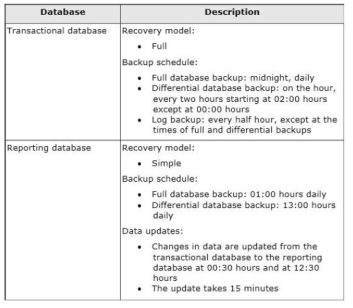
At 16:20 hours, you discover that pages 17, 137, and 205 on one of the database files are corrupted on the transactional database. You need to ensure that the transactional database is restored. You also need to ensure that data loss is minimal.
What should you do?
A. Perform a partial restore.
B. Restore the latest full backup, and restore the latest differential backup. Then, restore each log backup taken before the time of failure from the most recent differential backup.
C. Perform a point-in-time restore.
D. Restore the latest full backup.
E. Restore the latest full backup, and restore the latest differential backup. Then, restore the latest log backup.
F. Perform a page restore.
G. Restore the latest full backup. Then, restore each differential backup taken before the time of failure from the most recent full backup.
H. Restore the latest full backup. Then, restore the latest differential backup.
70-462 vce Answer: F
Explanation:
Requirements for Restoring Pages
A page restore is subject to the following requirements:
The databases must be using the full or bulk-logged recovery model. Some issues exist if you are using the bulk-logged model. For more information, see the following section. Pages in read-only filegroups cannot be restored. Trying to make a filegroup read only will fail if there is a page restore going on at the same time in the filegroup. The restore sequence must start with a full, file, or filegroup backup. A page restore requires an unbroken chain of log backups up to the current log
file, and they must all be applied so that the page is brought up to date with the current log file.
As in a file-restore sequence, in each restore step, you can add more pages to the roll forward set. A database backup and page restore cannot be run at the same time.
Bulk-logged Recovery Model and Page Restore
For a database that uses the bulk-logged recovery model, page restore has the following additional conditions:
Backing up while filegroup or page data is offline is problematic for bulk-logged data, because the offline data is not recorded in the log. Any offline page can prevent backing up the log. In this cases, consider using DBCC REPAIR, because this might cause less data loss than restoring to the most recent backup.
If a log backup of a bulk-logged database encounters a bad page, it fails unless WITH CONTINUE_AFTER_ERROR is specified. Page restore generally does not work with bulk-logged recovery. A best practice for performing page restore is to set the database to the full recovery model, and try a log backup. If the log backup works, you can continue with the page restore. If the log backup fails, you either have to lose work since the previous log backup or you have to try running DBCC must be run with the REPAIR_ALLOW_DATA_LOSS option.
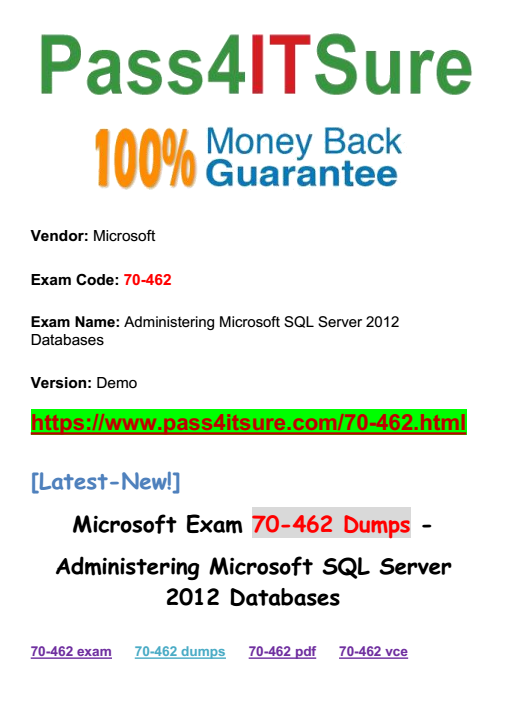
[New Updated Spring 2018 Microsoft 70-462 Dumps Updated From Google Drive]: https://drive.google.com/open?id=1H4CcMnBcyj0IAqqLhvMG7TM0K2eog1Bp
[New Updated Spring 2018 Microsoft 712-50 Dumps Updated From Google Drive]: https://drive.google.com/open?id=1-MjU6oJH8gscpAMif3u5JrXLEHU0exaf
70-462 (Administering Microsoft SQL Server 2012 Databases) is the part of Microsoft (MCP, MCSA, MCSE) certification. This 70-462 exam also targets a candidate’s ability to work efficiently with the Microsoft MCSE Business Intelligence. Pass4itsure has a team of Microsoft experts to develop the best 70-462 dumps exam products, which covers all the knowledge points of the real Microsoft exam. Pass4itsure Cisco 70-462 dumps exam questions answers are updated (248 Q&As) are verified by experts.

See What Our Customers Are Saying:
We at Pass4itsure are committed to our customer’s success. Passing 70-462 exam will enhance your career as a Microsoft MCSE Business Intelligence and will help you to stand apart from the crowd with a proven skill. Our Microsoft 70-462 dumps are created with utmost care and professionalism. A link https://www.pass4itsure.com/70-462.html is given so that you can start your practice as soon as possible.

If you need to take this exam then you need to get registered at the Microsoft for this particular 70-462 dumps exam. The link has a total of 248 questions with answers. The questions are in MCQS format and you can also download them for later use. Compared with other brands, Pass4itsure has up to dated exam information, affordable price, instant exam PDF files downloaded, error correction, unlimited install,etc. Such as Pass4itsure Up To Date Microsoft 70-462 Dumps Doc, Real Microsoft 70-462 Dumps Certification Braindumps Guaranteed Success, We Help You Pass Administering Microsoft SQL Server 2012 Databases.